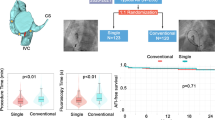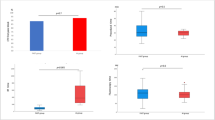Abstract
Background
Different types of irrigated-tip ablation catheters are available for ablation of atrial flutter (AFL). The aim of this study was to compare an established with a novel dedicated Gold irrigated-tip catheter for ablation of AFL.
Methods and results
We compared consecutive patients undergoing ablation of AFL using a standard 3.5 mm irrigated-tip platinum–iridium (Pt–Ir) catheter (Thermocool, TC-group) and a 3.5 mm irrigated gold-tip catheter (Gold-group) specifically designed for cavotricuspid isthmus ablation (CTI). The primary endpoint was acute efficacy (net RF time) to achieve block across the CTI. Secondary endpoints included procedure time, fluoroscopy duration, complications, and recurrence of AFL.153 patients (age 68 ± 11 years, 74% male) were included. Net RF time to achieve CTI block was not different between the TC-group (793 ± 503 s) and the Gold-group (706 ± 422 s; p = 0.406). Total procedure time was not significantly different between the TC-group (70 ± 26 min) and the Gold-group (70 ± 27 min; p = 0.769). A significant difference between the groups was identified for the fluoroscopy duration (TC-group: 934 ± 537 s, Gold-group: 596 ± 362 s, p < 0.001). There were no major complications observed in the groups. Recurrence of AFL occurred in 3 of 66 (5%) in the TC-group and in 2 of 87 (2%) in the Gold-group (p = 0.652).
Conclusions
In conclusion, acute and chronic efficacy of the irrigated Pt–Ir and gold-tip catheters were comparable. However, the dedicated catheter design was associated with decreased fluoroscopy duration.



Similar content being viewed by others
References
Kirkorian G, Moncada E, Chevalier P, Canu G, Claudel JP, Bellon C et al (1994) Radiofrequency ablation of atrial flutter. Efficacy of an anatomically guided approach. Circulation 90:2804–2814
Feld GK, Fleck RP, Chen PS, Boyce K, Bahnson TD, Stein JB et al (1992) Radiofrequency catheter ablation for the treatment of human type 1 atrial flutter. Identification of a critical zone in the reentrant circuit by endocardial mapping techniques. Circulation 86:1233–1240
Jaïs P, Shah DC, Haïssaguerre M, Hocini M, Garrigue S, Le Metayer P et al (2000) Prospective randomized comparison of irrigated-tip versus conventional-tip catheters for ablation of common flutter. Circulation 101:772–776
Feld GK, Daubert JP, Weiss R, Miles WM, Pelkey W, Cryoablation Atrial Flutter Efficacy Trial Investigators (2008) Acute and long-term efficacy and safety of catheter cryoablation of the cavotricuspid isthmus for treatment of type 1 atrial flutter. Heart Rhythm 5:1009–1014
Scavée C, Jaïs P, Hsu L-F, Sanders P, Hocini M, Weerasooriya R et al (2004) Prospective randomised comparison of irrigated-tip and large-tip catheter ablation of cavotricuspid isthmus-dependent atrial flutter. Eur Heart J 25:963–969
Lewalter T, Bitzen A, Wurtz S, Blum R, Schlodder K, Yang A et al (2005) Gold-tip electrodes—a new “deep lesion” technology for catheter ablation? In vitro comparison of a gold alloy versus platinum-iridium tip electrode ablation catheter. J Cardiovasc Electrophysiol 16:770–772
Lewalter T, Weiss C, Spencker S, Jung W, Haverkamp W, Willems S et al (2011) AURUM 8 Study Investigators. Gold vs. platinum-iridium tip catheter for cavotricuspid isthmus ablation: the AURUM 8 study. Europace 13:102–108
Pérez FJ, Schubert CM, Parvez B, Pathak V, Ellenbogen KA, Wood MA (2009) Long-term outcomes after catheter ablation of cavo-tricuspid isthmus dependent atrial flutter: a meta-analysis. Circ Arrhythm Electrophysiol 2:393–401
Scaglione M, Caponi D, Di Donna P, Riccardi R, Bocchiardo M, Azzaro G et al (2004) Typical atrial flutter ablation outcome: correlation with isthmus anatomy using intracardiac echo 3D reconstruction. Europace 6:407–417
Knecht S, Castro-Rodriguez J, Verbeet T, Damry N, Morissens M, Tran-Ngoc E et al (2007) Multidetector 16-slice CT scan evaluation of cavotricuspid isthmus anatomy before radiofrequency ablation. J Interv Card Electrophysiol 20:29–35
Malmborg H, Lönnerholm S, Lundqvist CB (2009) A prospective randomised comparison of large-tip cryoablation and 8-mm-tip radiofrequency catheter ablation of atrial flutter. J Interv Card Electrophysiol 24:127–131
Timmermans C, Ayers GM, Crijns HJGM, Rodriguez L-M (2003) Randomized study comparing radiofrequency ablation with cryoablation for the treatment of atrial flutter with emphasis on pain perception. Circulation 107:1250–1252
Ilg KJ, Kühne M, Crawford T, Chugh A, Jongnarangsin K, Good E et al (2011) Randomized comparison of cavotricuspid isthmus ablation for atrial flutter using an open irrigation-tip versus a large-tip radiofrequency ablation catheter. J Cardiovasc Electrophysiol 22:1007–1012
Linhart M, Mollnau H, Bitzen A, Wurtz S, Schrickel JW, Andrié R et al (2009) In vitro comparison of platinum-iridium and gold tip electrodes: lesion depth in 4 mm, 8 mm, and irrigated-tip radiofrequency ablation catheters. Europace 11:565–570
Venier S, Andrade JG, Khairy P, Mondésert B, Dyrda K, Rivard L, et al (2017) Contact-force-guided vs. contact-force-blinded catheter ablation of typical atrial flutter: a prospective study. Europace 19:1043–1048
Matsuo S, Yamane T, Tokuda M, Date T, Hioki M, Narui R et al (2010) Prospective randomized comparison of a steerable versus a non-steerable sheath for typical atrial flutter ablation. Europace 12:402–409
Author information
Authors and Affiliations
Corresponding author
Ethics declarations
Conflict of interest
Sven Knecht—received compensation for advisory boards with Boston Scientific and Biotronik. Fabian Burch—no conflict of interest. Aline Mühl—no conflict of interest. Florian Spies—no conflict of interest. Tobias Reichlin—no conflict of interest. Beat Schaer—no conflict of interest. David Altmann—no conflict of interest. Peter Ammann—no conflict of interest. Stefan Osswald—no conflict of interest. Christian Sticherling—Advisory Board of Medtronic and Biotronik, received educational grants from Biotronik and research Grant from Biosense Webster (outside the submitted work). Michael Kühne—proctor for Medtronic, speakers bureau for Boston Scientific, St Jude Medical, and Biotronik.
Funding
No funding.
Ethical approval
All procedures performed in studies involving human participants were in accordance with the ethical standards of the institutional and/or national research committee and with the 1964 Helsinki declaration and its later amendments or comparable ethical standards.
Informed consent
Informed consent was obtained from all individual participants included in the study.
Rights and permissions
About this article
Cite this article
Knecht, S., Burch, F., Reichlin, T. et al. First clinical experience of a dedicated irrigated-tip radiofrequency ablation catheter for the ablation of cavotricuspid isthmus-dependent atrial flutter. Clin Res Cardiol 107, 281–286 (2018). https://doi.org/10.1007/s00392-017-1180-4
Received:
Accepted:
Published:
Issue Date:
DOI: https://doi.org/10.1007/s00392-017-1180-4




